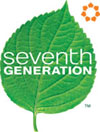Case studies show how leading businesses are eliminating toxic chemicals from their supply chains, asking chemical manufacturers for more safety information, and calling on Congress to put common-sense limits on chemicals that could harm their customers.

By Dave Rapaport, Director of Corporate Consciousness, Seventh Generation
At Seventh Generation we work with our supply chain partners to make cleaning, baby and feminine personal care products that are healthy and safe for the air, the surfaces, the fabrics, the pets and the people within the home—and for the community and environment outside it. One of the country’s first self-declared “socially responsible” companies, Seventh Generation has been at the forefront of a cultural change in consumer behavior and business ethics for 20 years. For Seventh Generation sustainability is a core product concern along with the traditional concerns of price, efficacy, manufacturing capability and quality assurance.
Product Design
We start with policies and standards that guide the design and formulation of our products to ensure they meet the highest standards of environmental and human safety. These standards include a prohibition on carcinogens, chlorine bleach and phosphates as ingredients, as well as standards for overall product toxicity, eye and skin irritation, biodegradability and a host of other human health and environmental safety criteria.
We carefully track compliance with these standards, relying on a combination of our own in-house review and qualified third parties for expertise and independent judgment. This includes periodic authenticity testing of products and ingredients for a wide range of potentially harmful trace materials including: 1,4-dioxane, phthalates, metals, chlorine, formaldehyde, tributyl tin, phosphates and pesticides.
Even with these standards and policies, we know we’re on an endless journey of ongoing improvement to formulate the safest, most effective and most environmentally restorative products possible. As a company, we not only want to make products that don’t harm human health and the environment during their entire earth-to-earth (life cycle) existence, but we want to make products that help restore balance to damaged human and natural systems.
This is no easy task. Many of the ingredients we would like to use for our products currently don’t exist. As a result, a few of our products do not meet all of our standards, and none of our products fully meet our aspirations of using only sustainably sourced ingredients. And while all of our products are safe for people and the environment, there are still some ingredients in them we’re striving to replace. These include some ethoxylated surfactants (plant-based cleansers modified with synthetic chemicals) in our laundry detergents and very low concentrations of preservatives required to prevent microorganisms from growing in our nontoxic cleaners.
Hazardous chemicals can enter our products as contaminants even when neither our manufacturers nor our suppliers intentionally add them. For example, 1,4 dioxane, a possible human carcinogen can be formed during the manufacture of cleaning agents used in some of our products—including our dish washing and laundry detergents—when plant-based oils are modified in order to increase their effectiveness. For a number of years we have required our suppliers to use vacuum stripping to limit the presence of 1,4 dioxane in these ingredients to no more than 5 parts per million (well below levels of concern, with levels in formulated products much lower). In 2009, we were able to reformulate our dish liquid and several spray cleaners with ingredients completely free of 1,4 dioxane, and in 2010 are reformulating our laundry detergent to further reduce this contaminant.
In a second example, recent testing detected small amounts of di(2-ethylhexyl) phthalate (DEHP) in our undiluted essential oil blends prior to their use in our formulations. DEHP, a common softening agent added to PVC plastic tubing and a reproductive toxicant, appears to be present as a result of the equipment used in processing oil blends. Our suppliers are developing strategies to reduce DEHP contamination in our products.
Seventh Generation, Inc.
- A leading brand of natural household and personal care products, including cleaners, paper, baby and feminine care products sold in a variety of retail channels primarily in the US and Canada and on the internet and at military commissaries worldwide.
- Privately held company based in Burlington, Vermont.
- Name comes from the Great Law of the Iroquois that states, “In our every deliberation, we must consider the impact of our decisions on the next seven generations.”
Sustainable Sourcing
To enable Seventh Generation to trace raw material ingredients and packaging components to their sources, we are moving away from distributors to consolidate our purchases and contract directly with ingredient manufacturers. Not only does this give us a lower price, it allows us to develop closer supplier relationships so we can ensure that our strategic raw material and packaging suppliers understand the level of sustainability we’re seeking and partner with us in our efforts and support standard setting. By controlling this sourcing function, we reduce the risk of poorly screened ingredients finding their way into our products while also gaining a better view into the full supply chain. Moreover, we are able to award business to suppliers who share our values around transparency, disclosure and traceability. This approach deepened our supplier relationships, reduced our costs and improved our ability to control the specifications for our raw materials.
Product Labeling of all Ingredients
Nature never intended babies to enter the world with an average of 200 industrial chemicals in their blood stream. Incredibly, that’s what the Environmental Working Group found when they tested the umbilical blood of babies at birth. Most parents will find that worrying, if not downright terrifying. Unfortunately, if they want to do something about it, they’ll have a difficult time. Manufacturers of cleaning products are not required by law to disclose their ingredients.
Seventh Generation believes full ingredient transparency is necessary for consumers to verify the health and safety of the cleaners they use. We fully disclose the ingredients in our products on the label, including explanations of each ingredient in a format guided by federal requirements for cosmetics. In addition the ingredients and material safety data sheets (MSDSs) are available on our website, as are disclosures of trace materials that may be present when known.
We canvassed the entire cleaning aisle and were astounded to see how many products have no information or confusing terminology. Few people understand what’s meant by “adequate ventilation,” for example. Consequently, Seventh Generation created a Label Reading Guide, an interactive glossary of terms and ingredients commonly found on household cleaning product labels. Now shoppers can print our Guide or query it on their phones in the store aisle and make an informed choice.
Voluntary Industry Reform
Seventh Generation actively participates in the historically conservative Soap and Detergent Association (SDA). In 2008, the SDA announced a voluntary communication program, something we have been pushing for a long time. The program requires adherents to:
- List ingredients in descending order of predominance to one percent (below that in any order) in the product.
- Use consistent labeling criteria established by either: the International Nomenclature of Cosmetic Ingredients (INCI), the more exacting International Union of Pure and Applied Chemistry (IUPAC) nomenclature or to simply use common chemical names.
- Have complied with these requirements by January 1, 2010.
In a decisive break with the secrecy of the past, 12 of the approximately 30 companies (representing 90% of the products in the market and including major players such as P&G, SC Johnson and Clorox) have signed up so far. Unfortunately, most cleaning products companies are bypassing disclosure on product labels and choosing only website disclosure.
Safer Chemicals Policy Reform
Seventh Generation supports federal safer chemicals reform that moves the market to inherently safer chemicals. Specifically, we need:
- No data, no market. Make data submission a requirement before bringing any chemical to market. Chemical manufacturers need to submit comprehensive hazard data to the US Environmental Protection Agency (EPA) and the agency needs to make it readily available to the public.
- Take immediate action to reduce the use of persistent, bioaccumulative and toxic (PBT) chemicals and other chemicals of high concern. As uniquely hazardous chemicals, PBT use needs to be phased out to the fullest extent possible. Exposure to other toxic chemicals, such as formaldehyde, which has already been extensively studied, should be reduced to the maximum extent feasible and substituted with safer alternatives.
- Clearly identify chemicals of high and low concern to human and environmental health based on robust information. We need a credible, transparent source of information that identifies chemicals of high as well as low concern and transparently communicates what we know and don’t know about chemicals on the market.
- Require greater disclosure of chemicals in products. Federal policy should require that companies using chemicals of concern in products disclose their presence to customers and the public as well as to the government. Such a requirement will directly address a significant barrier to implementing green chemistry at the user level: the lack of information on the chemical constituents in products.
- Promote safer alternatives. The EPA needs to expand and intensify its efforts to promote safer alternatives. Green chemistry research should be prioritized and policy incentives developed to promote and facilitate the use of safer chemicals over those with known health hazards.
Together, these elements of comprehensive safer chemicals reform will create an effective and trusted regulatory system that enhances the value of products across their supply chain.



